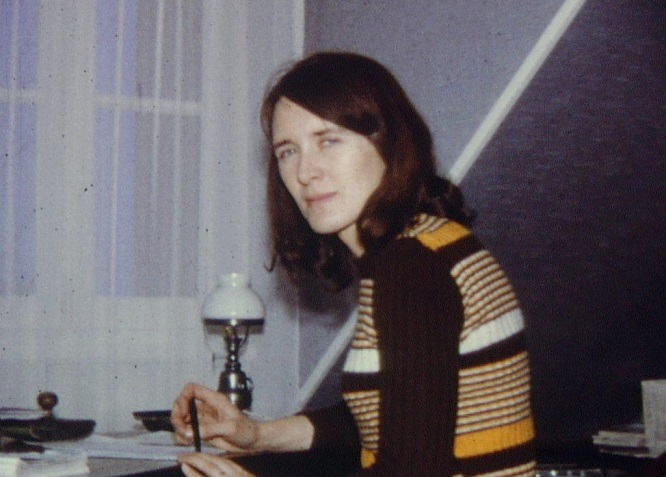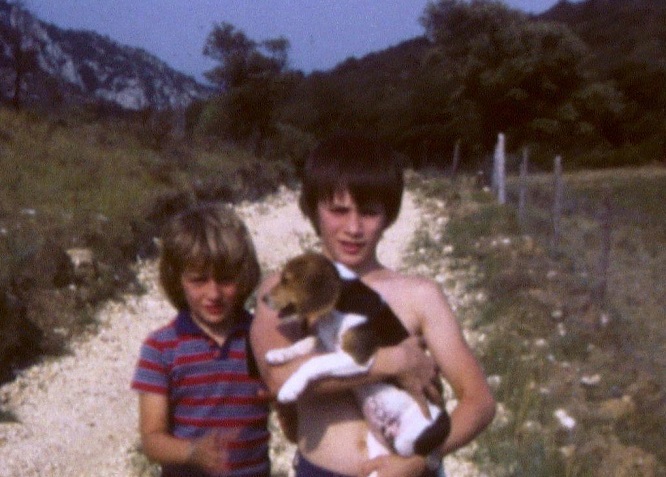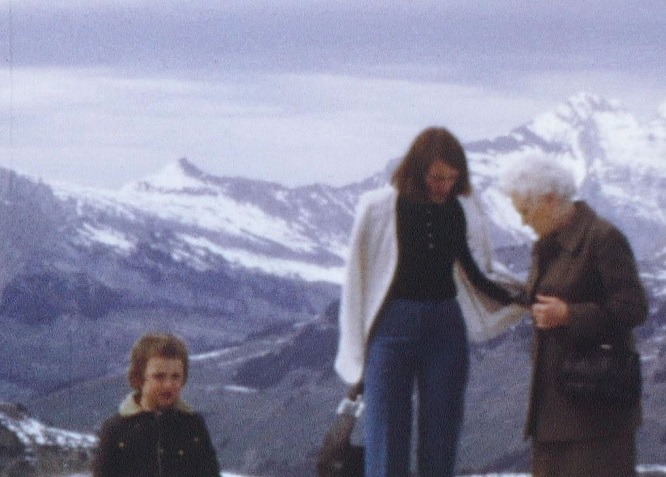

:: Annie Ernaux in Les années Super 8 (Annie Ernaux et David Ernaux-Briot, 2022) [Les Films Pelléas]
The beaches of Cannes trembled with the news. The great French writer Annie Ernaux, winner of the Nobel Prize for literature, had made a movie with her son David. Soon, it would show at the Festival. What mysteries would be revealed about a writer who seemed willing to share every intimate detail of her life in a score of memoir-fictions that had brought her to the most visible place in literature?
The movie’s origins lie, like all of Annie’s works, with a family evening. She is visiting the home of her son David, where his kids have asked to see some of the home movies shot when David was their age. As the old Super 8 reels stumble through the projector, Annie begins to talk, to comment on what they are seeing. When the evening is over, David asks his famous mother if she would write a text to accompany these images. It is this text that would eventually guide the film’s editing.
The footage had already served as pretext and inspiration for Annie Ernaux. She re-viewed it while working on her masterpiece, The Years (2008), an epic memoir that spans the course of her life, deftly weaving intimate moments with revolutions abroad, feminism and nuclear anxieties, the consumer class. In her work, the self appears permeable and shape-shifting, inseparable from the stories and struggles surrounding it. Shortlisted for the Man Booker International Prize in 2019, The Years helped deliver her to a wide English-speaking audience. Fifteen years later, it became the template for The Super 8 Years (2022).
Yesterday, it came to me with certainty that I write my love stories and live my books, in a perpetual round dance.— Getting Lost (p. 171)
Released by Eastman Kodak in 1965 at the World’s Fair, Super 8 film was part of the double wave of consumerism and scientific utopia that emerged in the 1960s and 1970s. It was a way for capital to penetrate and reimagine domestic space, part of a new series of control mechanisms that would reliably deliver ruling class dreams. There are two subjects that became mainstays of the home movie: opening presents at Christmas and the travelogue. The Super 8 Years embraces both trends. Between episodes of consumer product display, there are a series of trips that begin with a vacation in revolutionary Chile, where Allende’s new socialist government is busy giving land to peasants, with immanent hopes of nationalizing coal and oil production. But US President Nixon’s financial backers have deep investments in Chile that require him to foment a coup that would kill Allende and replace him with a ruthless dictator who terrorized the country for 17 years. Shortly after Ernaux’s visit, good government, meaning the siphoning of wealth to the US, was once again established.
In Morocco, the family lounges by the pool, they touch down in post-Franco Spain, glimpse the last years of the Eastern Bloc. In Beyrouth, they fear the Red Army Faction, the West German urban guerilla group who railed against the fascist state, murdering and kidnapping industrialists, robbing banks and issuing manifestos. Though, by the time the family arrives, the Faction’s leaders have all died in prison. On the beaches of Albania, Ernaux dryly observes, “we invented a happiness there that migrants would seek years later.”

:: David and Éric Ernaux [Les Films Pelléas]
Her husband is always named Phillippe Ernaux. Never “my husband,” “my darling,” or even “him.” Instead, the formality of his full name is rolled out, as if he were someone she met one afternoon by accident at a bistro. They were together for 18 years. When the marriage finally dissolves, she is left with the rolls of him he shot, and the projector; she becomes the keeper of memory, while he leaves with the camera. Here, they observe another commonplace practice of the Super 8 home movie—the father is the one behind the camera. He is seldom seen, as if the family scenes that are the focus of his attention are something separate from him, that he has no part in except as observer, the silent and unseen controller of events.
The footage was shot between 1972 and 1981, and, as the years pass, the family slowly exits the frame. As the distance between Philippe and Annie Ernaux grows wider, the camera searches out objects and landscapes, monuments of distraction. What is being filmed is the dissolution of their marriage, though what is missing is increasingly more important than what is being shown. Is it strange that, in the hundreds of hours of home movie I’ve watched, I have never seen a domestic argument, the cruel treatment of a child, the betrayal of adults, the infidelities and cover-ups, the mesh and weave of everyday life? In its place is a record of “what makes us happy, of what we will never see again,” as Ernaux puts it, in other words the “proper face” of a family is on display. Here are scenes deemed safe enough to share, even though, ironically, the exclusive audience is also the subjects inside the frame. It’s as if the camera is being picked up so that the family can be watched by the pictures they produce.
Most of all it [writing] was a way to save life, save from nothingness the thing that most resembles it.— Getting Lost (p. 8)
A mysterious thread runs throughout the film. The portrait of an artist busy pretending she is not an artist. In the early 1970s, Annie begins to work on her first novel in secret. Just as her university education separated her from her working-class parents, her writing is a way for her to leave the family, or at least, to reimagine her place within it by creating a new identity, a new space for expression that must belong to her alone. She leans on her mother for help. Her mother lives with the family, happy to spend time with the grandchildren, performing the familiar duties of care, the work of reproduction. In these stolen hours, Annie begins her career as a writer. The subject of her first book is an abortion she had when she was 24, still a student. Even as her young family careens around her, she reflects on the lives that might have been, and on the deep humiliation and sense of doom she felt as she saw herself slipping back into the peasant universe of her upbringing. Her writing, like her abortion, are ways to escape the fate of her parents.
…my mother had to die and I to write about her, to finally “be” her.— Getting Lost (p. 233)

:: The Ernaux family [Les Films Pelléas]
The five-star publisher Gallimard is interested in her first book. The second follows, a third and fourth. They are thinly disguised fictions drawn from her own life, filled with pitiless details, written in brief poetic bursts that reflect on her experience, as if she were a character in a novel. When she remarks on her own youthful face looking back at the camera of Philippe Ernaux, she says, “I felt like a spectator.” As if she were watching herself and her partner, and every family member, playing their expected roles. For reasons she would explore with surgical detail in the novels to come, she was unable to accept her assigned place as wife and mother, and the accompanying duties. “I thought men and women were equal,” she says with a note of surprise that she was ever so young. It is out of this dissatisfaction, which couldn’t be more personal, but at the same time, was part of a societal problem, that she begins to write, to find her voice.
In Spain, she is pictured in a wide shot, pushing against a brick wall that winds through a vast green landscape. The old certainties are difficult to budge, they have endured for centuries. How could a woman bring that wall down, and begin her life? How could she find the words to talk about everything when she was mired in the details? She would use Simone de Beauvoir as a compass, commit herself to the endless hours of solitude required to learn her trade. As she looks into the reels of film, she notes, “Words were needed to give meaning to this silent time.” The silence she recalls belongs not only to the footage itself, which records images and not sounds, but also to the family pictured there. The voice-over offers each of these characters a way out, a release and liberation. For the past decades, the need to break this silence has been a powerful engine for Annie Ernaux.
I have to write something that puts me in danger, like a cellar door that opens and must be entered, come what may.— Getting Lost (p. 239)
*
Mike Hoolboom began making movies in 1980. Making as practice, a daily application. Ongoing remixology. Since 2000 there has been a steady drip of found footage bio docs. The animating question of community: how can I help you? Interviews with media artists for 3 decades. Monographs and books, written, edited, co-edited. Local ecologies. Volunteerism. Opening the door.
 |
envoyer par courriel | 
| imprimer | Tweet |
